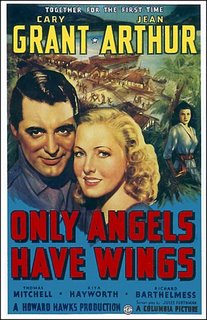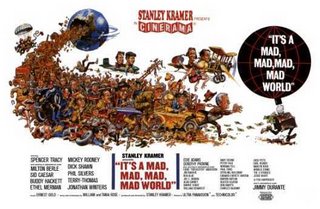Only Angels Have Wings
 With escapism at its peak in the 1930’s, movies about brave men doing noble things were quite common. This theme of bravado and derring-do was prevalent in a number of the films of director Howard Hawks. One such film is “Only Angels Have Wings”, a love letter to aviators, who defy death for the love of being in the air. The film simply glorifies the aviators and their devil-may-care lifestyle. Of course, this being the 1930’s, and this being a Howard Hawks film, there is more to it; the film’s location is an exotic South American location, Barranca, and is peppered with many familiar faces, including leading man Cary Grant, leading lady Jean Arthur, an early supporting turn from recently dubbed Rita Hayworth (previously billed as Rita Cansino), silent film star Richard Barthelmess, and a great turn by celebrated character actor Thomas Mitchell, who appeared in several other classic films that same year: “Gone With the Wind”, “Mr. Smith Goes to Washington”, “The Hunchback of Notre Dame” and “Stagecoach”, for which he would win a Supporting Actor Oscar. Somewhat forgotten today, given that 1939 is generally regarded as the greatest year in cinema history, “Only Angels Have Wings” is a fine collection of acting, directing, and writing, a typical studio picture of the time and as with most neglected gems of the time, one that is well worth revisiting today. There are a few troubling aspects of the film which reflect poorly on it today however: a jingoistic tone permeates throughout (the natives and their culture are acknowledged, but definitely not embraced) and there is one truly shocking scene in which condors are dispatched with a surplus of nitroglycerine that has to be seen in all its blissful ignorance to be believed. Most films of the old studio era come with a few caveats today, but they should not prevent this film from being remembered.
With escapism at its peak in the 1930’s, movies about brave men doing noble things were quite common. This theme of bravado and derring-do was prevalent in a number of the films of director Howard Hawks. One such film is “Only Angels Have Wings”, a love letter to aviators, who defy death for the love of being in the air. The film simply glorifies the aviators and their devil-may-care lifestyle. Of course, this being the 1930’s, and this being a Howard Hawks film, there is more to it; the film’s location is an exotic South American location, Barranca, and is peppered with many familiar faces, including leading man Cary Grant, leading lady Jean Arthur, an early supporting turn from recently dubbed Rita Hayworth (previously billed as Rita Cansino), silent film star Richard Barthelmess, and a great turn by celebrated character actor Thomas Mitchell, who appeared in several other classic films that same year: “Gone With the Wind”, “Mr. Smith Goes to Washington”, “The Hunchback of Notre Dame” and “Stagecoach”, for which he would win a Supporting Actor Oscar. Somewhat forgotten today, given that 1939 is generally regarded as the greatest year in cinema history, “Only Angels Have Wings” is a fine collection of acting, directing, and writing, a typical studio picture of the time and as with most neglected gems of the time, one that is well worth revisiting today. There are a few troubling aspects of the film which reflect poorly on it today however: a jingoistic tone permeates throughout (the natives and their culture are acknowledged, but definitely not embraced) and there is one truly shocking scene in which condors are dispatched with a surplus of nitroglycerine that has to be seen in all its blissful ignorance to be believed. Most films of the old studio era come with a few caveats today, but they should not prevent this film from being remembered.As the film opens, Bonnie Lee, improbably a chorus girl on layover in Barranca, and even more improbably played by wholesome Jean Arthur, is followed by two of the fliers. Vying for her affections they both invite Bonnie back to the bar/restaurant/hotel they frequent, which is owned and operated by Dutchy, played by another great character actor, Sig Ruman, better known for his clowning with the Marx Brothers and other comedic turns. Dutchy also owns the mail-by-air company all the fliers work for, and the company is not doing well. Managed on a day to day basis by Geoff Carter, the improbably swashbuckling aviator played by Cary Grant, Geoff understands the sacrifices he and his men must make, most significantly taking their life in their hands every time they take off. Given the financial troubles Dutchy is embroiled in with the company, Geoff has been pushing his men hard to insure Dutchy gets his contract renewed and subsidized; that means a higher number of dangerous flights, through driving rain, dense fog and blinding snow higher up in the Andes. When one of the fliers (sent on the mission by shrewd ladies man Geoff so he can make time with Bonnie) becomes impatient, fearing if he does not land quickly he will lose his chance with Bonnie, he plans a reckless landing. Despite Geoff’s warning, a landing is almost impossible given the thick fog and the plane comes down in a spectacular crash. Bonnie is horrified, blaming herself for the terrible accident, but she is even more revolted by the apparent lack of compassion the men show, immediately returning to dinner, drinks and music. Geoff explains that dwelling on the dangers would be even worse for the men, that they are all well aware of the dangers inherent with the job. Bonnie also learns from ‘the Kid’, Geoff’s best friend and fellow flier, that he usually takes the most dangerous flights himself, risking his own safety over that of his men. This softens Bonnie’s heart somewhat, and she, of course, becomes attracted to the charismatic Geoff and his “daring young men in their flying machines”.
Amidst the blossoming love affair between Bonnie and Geoff comes a mysterious new flier, Kilgallen, and his beautiful young wife, Judy. Complicating things is the history each of them has with Kid and Geoff, respectively. Borrowing from a true story Howard Hawks was familiar with, Kilgallen (an assumed name) has been largely blacklisted from the aviator community after he parachuted from a plane going down, leaving his co-pilot to crash. That co-pilot was the Kid’s brother. Judy, played by the devastatingly beautiful Rita Hayworth, was Geoff’s old girlfriend, but he ended things when he fell too in love with her that it was affecting flying. He has sworn never to tell a woman what to do ever again, complicating things with Bonnie when he obviously wants her to stay, but cannot bring himself to ask her to. While minor sparks fly between Geoff and Judy, the real drama is between the Kid and Kilgallen. To make matters worse, Geoff has grounded the Kid because of failing eyesight, however after a series of circumstances leaves only the Kid and Kilgallen available to make the last flight needed to insure Dutchy’s contract, the two reluctantly partner up. After encountering bad weather while navigating a treacherous pass in the Andes, their plane sustains major damage and they have to crash land. The Kid is fatally wounded, but with his last breath instructs Kilgallen to jump to safety. Kilgallen refuses and lands the plane, suffering serious burns himself. After landing, Kilgallen has the respect of the men of the company now, including Geoff, who had treated him as a necessity, not a friend until then. The film ends with Bonnie, exasperated with Geoff’s commitment phobia, imploring him to just say the word and she will stay. Geoff offers to flip a coin to decide whether she will or not, before he takes off on another flight. Geoff wins and Bonnie is frustrated that he found a loophole to get her to stay, until she realizes the coin was the Kid’s trick coin, with both sides ‘heads’, meaning she was staying no matter what. Lost in the shuffle among films such as “Gone With the Wind” and “The Wizard of Oz” from the same year, “Only Angels Have Wings” is a perfect example of classic “Old Hollywood” filmmaking.

